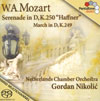Mozart March in D K249; Serenade in D 'Haffner' K250
An excellent release exhibiting Nikolitch as conductor, arranger and solo violinist
View record and artist detailsRecord and Artist Details
Composer or Director: Wolfgang Amadeus Mozart
Genre:
Orchestral
Label: Pentatone
Magazine Review Date: 1/2009
Media Format: Hybrid SACD
Media Runtime: 0
Catalogue Number: PTC5186097

Tracks:
| Composition | Artist Credit |
|---|---|
| March |
Wolfgang Amadeus Mozart, Composer
Gordan Nikolic, Conductor Wolfgang Amadeus Mozart, Composer |
| Serenade No. 7, "Haffner", Movement: Allegro maestoso Allegro molto |
Wolfgang Amadeus Mozart, Composer
Gordan Nikolic, Conductor Wolfgang Amadeus Mozart, Composer |
| Serenade No. 7, "Haffner", Movement: Andante |
Wolfgang Amadeus Mozart, Composer
Gordan Nikolic, Conductor Wolfgang Amadeus Mozart, Composer |
| Serenade No. 7, "Haffner", Movement: Menuetto |
Wolfgang Amadeus Mozart, Composer
Gordan Nikolic, Conductor Wolfgang Amadeus Mozart, Composer |
| Serenade No. 7, "Haffner", Movement: Rondo (Allegro) |
Wolfgang Amadeus Mozart, Composer
Gordan Nikolic, Conductor Wolfgang Amadeus Mozart, Composer |
| Serenade No. 7, "Haffner", Movement: Menuetto galante |
Wolfgang Amadeus Mozart, Composer
Gordan Nikolic, Conductor Wolfgang Amadeus Mozart, Composer |
| Serenade No. 7, "Haffner", Movement: Adagio Allegro assai |
Wolfgang Amadeus Mozart, Composer
Gordan Nikolic, Conductor Wolfgang Amadeus Mozart, Composer |
Author: Nalen Anthoni
Gordan Nikolitch goes further. He incorporates these instruments into the original format (as did Nikolaus Harnoncourt on a scrawny-sounding early CD), thus turning the Serenade into a fuller work. Harnoncourt also added timpani to the K249 March. Nikolitch doesn’t. This work has a stately expansiveness that only switches to a militaristic snap in the first movement of the Serenade, percussion now lending point both to a regal Allegro maestoso and, leading from it, a fiery alla breve Allegro molto. In the following Andante, the first of three “violin concerto” movements, Nikolitch shows that he is as superlative a violin soloist as he is a conductor, as unerring in his understanding of lyrical eloquence as he is of dramatic timing. He never puts a foot wrong. Neither does Pentatone’s production, which keeps the perspectives steady (for example, the violin is properly balanced with the ensemble and not pulled forward for the cadenzas). The range, transparency and tonal veracity of the recording offer a total vindication of SACD. This is a tremendous disc.
Discover the world's largest classical music catalogue with Presto Music.

Gramophone Digital Club
- Digital Edition
- Digital Archive
- Reviews Database
- Full website access
From £8.75 / month
Subscribe
Gramophone Full Club
- Print Edition
- Digital Edition
- Digital Archive
- Reviews Database
- Full website access
From £11.00 / month
Subscribe
If you are a library, university or other organisation that would be interested in an institutional subscription to Gramophone please click here for further information.




